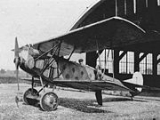
Fokker D.VII
Discussions
Encyclopedia
The Fokker D.VII was a German
World War I
fighter aircraft
designed by Reinhold Platz
of the Fokker-Flugzeugwerke. Germany produced around 3,300 D.VII aircraft in the summer and autumn of 1918. In service, the D.VII quickly proved itself to be a formidable aircraft. The Armistice
ending the war specifically required Germany to surrender all D.VIIs to the Allies at the conclusion of hostilities. Surviving aircraft saw continued widespread service with many other countries in the years after World War I.
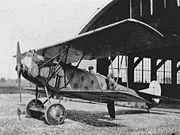
 Fokker's chief designer, Reinhold Platz, had been working on a series of experimental planes, the V-series, since 1916. These planes were characterized by the use of cantilever wings, first developed during Fokker's government-mandated collaboration with Hugo Junkers
Fokker's chief designer, Reinhold Platz, had been working on a series of experimental planes, the V-series, since 1916. These planes were characterized by the use of cantilever wings, first developed during Fokker's government-mandated collaboration with Hugo Junkers
. Junkers had originated the idea in 1915 with the first all-metal aircraft, the Junkers J 1
, nicknamed Blechesel ("Sheet Metal Donkey" or "Tin Donkey"). The resulting wings were thick, with a rounded leading edge. This gave greater lift and more docile stall
ing behavior than conventional thin wings.
Late in 1917, Fokker built the experimental V 11 biplane
, fitted with the standard Mercedes D.III
a engine. In January 1918, Idflieg held a fighter competition at Adlershof
. For the first time, frontline pilots would directly participate in the evaluation and selection of new fighters. Fokker submitted the V 11 along with several other prototypes. Manfred von Richthofen
flew the V 11 and found it tricky, unpleasant, and directionally unstable in a dive. In response to these complaints, Reinhold Platz lengthened the rear fuselage by one structural bay, and added a triangular fixed vertical fin in front of the rudder. Upon flying the modified V 11, Richthofen praised it as the best aircraft of the competition. It offered excellent performance from the outdated Mercedes engine, yet it was safe and easy to fly. Richthofen's recommendation virtually decided the competition, but he was not alone in recommending it. Fokker immediately received a provisional order for 400 production aircraft, which were designated D.VII by Idflieg.
Fokker's factory was not up to the task of meeting all D.VII production orders. Idflieg therefore directed Albatros
and AEG
to build the D.VII under license, though AEG did not ultimately produce any aircraft. Because the Fokker factory did not use detailed plans as part of its production process, Fokker simply sent a completed D.VII airframe for Albatros to copy. Albatros paid Fokker a five percent royalty for every D.VII built under license. Albatros Flugzeugwerke and its subsidiary, Ostdeutsche Albatros Werke (OAW), built the D.VII at factories in Johannisthal (designated Fokker D.VII (Alb)) and Schneidemühl (Fokker D.VII (OAW)), respectively. Aircraft markings included the type designation and factory suffix, immediately before the individual serial number.
Some parts were not interchangeable between aircraft produced at different factories, even between Albatros and OAW. Additionally each manufacturer tended to differ in nose paint styles. OAW produced examples were delivered with distinctive mauve and green splotches on the cowling. All D.VIIs were produced with the lozenge camouflage covering except for early Fokker-produced D.VIIs, which had a streaked green fuselage. Factory camouflage finishes were often overpainted with colorful paint schemes or insignia for the Jasta, or the individual pilot.
Albatros soon surpassed Fokker in the quantity and workmanship quality of aircraft produced. With a massive production program, over 3,000 to 3,300 D.VII aircraft were delivered from all three plants, considerably more than the commonly quoted but incorrect production figure of 1,700.
In September 1918, eight D.VIIs were delivered to Bulgaria. Late in 1918, the Austro-Hungarian company MÁG
(Magyar Általános Gépgyár - Hungarian General Machine Company) commenced licensed production of the D.VII with Austro-Daimler
engines. Production continued after the end of the war, with as many as 50 aircraft completed.
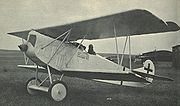 Many sources erroneously state that the D.VII was equipped with the 160 hp Mercedes D.III engine. The Germans themselves used the generic D.III designation to describe later versions of that engine. In fact, the earliest production D.VIIs were equipped with 170-180 hp Mercedes D.IIIa. Production quickly switched to the intended standard engine, the higher-compression 134 kW (180 hp) Mercedes D.III
Many sources erroneously state that the D.VII was equipped with the 160 hp Mercedes D.III engine. The Germans themselves used the generic D.III designation to describe later versions of that engine. In fact, the earliest production D.VIIs were equipped with 170-180 hp Mercedes D.IIIa. Production quickly switched to the intended standard engine, the higher-compression 134 kW (180 hp) Mercedes D.III
aü. It appears that some early production D.VIIs delivered with the Mercedes D.IIIa were later re-engined with the D.IIIaü.
By the summer of 1918, a number of D.VIIs received the "overcompressed" 138 kW (185 hp) BMW IIIa, the first product of the BMW
firm. The BMW IIIa followed the SOHC
, straight-six configuration of the Mercedes D.III, but incorporated several improvements. Increased displacement, higher compression, and an altitude-adjusting carburetor produced a marked increase in speed and climb rate at high altitude. Because the BMW IIIa was overcompressed, using full throttle at altitudes below 2,000 m (6,700 ft) risked premature detonation in the cylinders and damage to the engine. At low altitudes, full throttle could produce up to 179 kW (240 hp) for a short time. Fokker-built aircraft with the new BMW engine were designated D.VII(F), the suffix "F" standing for Max Friz
, the engine's designer. Some Albatros-built aircraft may also have received a separate designation.
BMW-engined aircraft entered service with Jasta 11
in late June 1918. Pilots clamored for the D.VII(F), of which about 750 were built. However, production of the BMW IIIa was very limited and the D.VII continued to be produced with the 134 kW (180 hp) Mercedes D.IIIaü until the end of the war.
D.VIIs flew with different propeller designs from different manufacturers. Despite the differing appearances there is no indication these propellers gave disparate performance. Axial, Wolff, Wotan, and Heine propellers have been noted.
 The D.VII entered squadron service with Jasta 10 in early May 1918. The type quickly proved to have many important advantages over the Albatros and Pfalz
The D.VII entered squadron service with Jasta 10 in early May 1918. The type quickly proved to have many important advantages over the Albatros and Pfalz
scouts. Unlike the Albatros scouts, the D.VII could dive without any fear of structural failure. The D.VII was also noted for its ability to climb at high angles of attack, its remarkably docile stall, and its reluctance to spin. It could literally "hang on its prop" without stalling for brief periods of time, spraying enemy aircraft from below with machine gun fire. These handling characteristics contrasted with contemporary scouts such as the Camel
and SPAD
, which stalled sharply and spun vigorously.
However, the D.VII also had problems. Several aircraft suffered rib failures and fabric shedding on the upper wing. Heat from the engine sometimes ignited phosphorus
ammunition until cooling vents were installed in the engine cowling, and fuel tanks sometimes broke at the seams. Aircraft built by the Fokker factory at Schwerin were noted for their lower standard of workmanship and materials. Nevertheless, the D.VII proved to be a remarkably successful design, leading to the familiar aphorism that it could turn a mediocre pilot into a good one, and a good pilot into an ace.
Manfred von Richthofen
died only days before the D.VII began to reach the Jagdstaffeln and never flew it in combat. Other pilots, including Erich Löwenhardt
and Hermann Göring
, quickly racked up victories and generally lauded the design. Aircraft availability was limited at first, but by July there were 407 on charge. Larger numbers became available by August, when D.VIIs achieved 565 victories. The D.VII eventually equipped 46 Jagdstaffeln. When the war ended in November, 775 D.VII aircraft were in service.
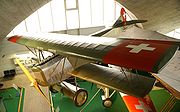 The Allies confiscated large numbers of D.VII aircraft after the Armistice
The Allies confiscated large numbers of D.VII aircraft after the Armistice
. The United States Army and Navy evaluated 142 captured examples. Several of these aircraft were re-engined with American-built Liberty L-6 motors, very similar in appearance to the D.VII's original German power plants. France, Great Britain, and Canada also received numbers of war prizes.
Other countries used the D.VII operationally. The Polish deployed approximately 50 aircraft during the Polish-Soviet War
, using them mainly for ground attack missions. The Hungarian Soviet Republic
used a number of D.VIIs, both built by MAG and ex-German aircraft in the Hungarian-Romanian War of 1919
.
The Dutch, Swiss and Belgian air forces also operated the D.VII. The aircraft proved so popular that Fokker completed and sold a large number of D.VII airframes that he had smuggled into the Netherlands after the Armistice. As late as 1929, the Alfred Comte
company manufactured eight new D.VII airframes under license for the Swiss Fliegertruppe
.
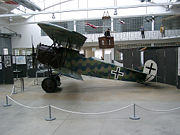
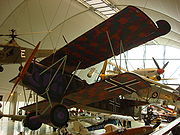 The widespread acquisition of the D.VII by Allied countries after the Armistice ensured the survival and preservation of several aircraft. One war prize was captured in 1918 when it accidentally landed at a small American airstrip near Verdun
The widespread acquisition of the D.VII by Allied countries after the Armistice ensured the survival and preservation of several aircraft. One war prize was captured in 1918 when it accidentally landed at a small American airstrip near Verdun
, France. Donated to the Smithsonian Institution
by the War Department in 1920, it is now displayed at the National Air And Space Museum
in Washington, D.C.
Two other American war prizes were retained by private owners until sold abroad in 1971 and 1981. They are today displayed at the Canada Aviation Museum
, in Ottawa
, Ontario
, and the Militaire Luchtvaart Museum in Soesterberg, Netherlands
, respectively. The latter aircraft is painted in fictitious Royal Netherlands Air Force
markings.
A former Marine Luchtvaartdienst D.VII was discovered in a German barn in 1948. This aircraft is now displayed at the Deutsches Museum
in Munich
, Germany
.
Both Canada and France also acquired numerous D.VII aircraft. A former war prize, one of 22 acquired by Canada, is displayed at the Brome County Historical Society, in the Knowlton neighborhood of Lac-Brome, Quebec. This unrestored Albatros-built example, serial number D.6810/18, is the only surviving D.VII that retains its original fabric covering. Of the aircraft sent to France, examples are today displayed at the Royal Air Force Museum in Hendon
, England
, and the Musée de l'Air et de l'Espace
in Paris
, France
.
inverted inline engines. These engines must be turned upright to produce the correct thrust line, thus requiring a new oiling system. A few flying replicas are equipped with original Mercedes D.IIIa engines.
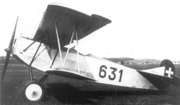 : Argentine Naval Aviation
: Argentine Naval Aviation
(postwar)
: 9 Squadron
(postwar)
: (postwar)
: (postwar)
: Finnish Air Force
(postwar)
 German Empire
German Empire
: (postwar)
: (postwar)
 Lithuania: (postwar)
Lithuania: (postwar)
: (postwar)
 Kingdom of Romania: (postwar)
Kingdom of Romania: (postwar)
: (postwar)
: (postwar)
 United States: (postwar)
United States: (postwar)
Germany
Germany , officially the Federal Republic of Germany , is a federal parliamentary republic in Europe. The country consists of 16 states while the capital and largest city is Berlin. Germany covers an area of 357,021 km2 and has a largely temperate seasonal climate...
World War I
World War I
World War I , which was predominantly called the World War or the Great War from its occurrence until 1939, and the First World War or World War I thereafter, was a major war centred in Europe that began on 28 July 1914 and lasted until 11 November 1918...
fighter aircraft
Fighter aircraft
A fighter aircraft is a military aircraft designed primarily for air-to-air combat with other aircraft, as opposed to a bomber, which is designed primarily to attack ground targets...
designed by Reinhold Platz
Reinhold Platz
Reinhold Platz was a German aircraft designer and manufacturer in service of the Dutch company Fokker....
of the Fokker-Flugzeugwerke. Germany produced around 3,300 D.VII aircraft in the summer and autumn of 1918. In service, the D.VII quickly proved itself to be a formidable aircraft. The Armistice
Armistice with Germany (Compiègne)
The armistice between the Allies and Germany was an agreement that ended the fighting in the First World War. It was signed in a railway carriage in Compiègne Forest on 11 November 1918 and marked a victory for the Allies and a complete defeat for Germany, although not technically a surrender...
ending the war specifically required Germany to surrender all D.VIIs to the Allies at the conclusion of hostilities. Surviving aircraft saw continued widespread service with many other countries in the years after World War I.
Development and production


Hugo Junkers
Hugo Junkers was an innovative German engineer, as his many patents in varied areas show...
. Junkers had originated the idea in 1915 with the first all-metal aircraft, the Junkers J 1
Junkers J 1
The Junkers J 1, nicknamed the Blechesel , was the world's first practical all-metal aircraft. Built early in World War I, when aircraft designers relied largely on fabric-covered wooden structures, the Junkers J 1 was a revolutionary development in aircraft design, being built and flown only 12...
, nicknamed Blechesel ("Sheet Metal Donkey" or "Tin Donkey"). The resulting wings were thick, with a rounded leading edge. This gave greater lift and more docile stall
Stall (flight)
In fluid dynamics, a stall is a reduction in the lift coefficient generated by a foil as angle of attack increases. This occurs when the critical angle of attack of the foil is exceeded...
ing behavior than conventional thin wings.
Late in 1917, Fokker built the experimental V 11 biplane
Biplane
A biplane is a fixed-wing aircraft with two superimposed main wings. The Wright brothers' Wright Flyer used a biplane design, as did most aircraft in the early years of aviation. While a biplane wing structure has a structural advantage, it produces more drag than a similar monoplane wing...
, fitted with the standard Mercedes D.III
Mercedes D.III
The Mercedes D.III, or F1466 as it was known internally, was a six-cylinder, liquid cooled inline aircraft engine built by Daimler and used on a wide variety of German aircraft during World War I. The initial versions were introduced in 1914 at 160 hp, but a series of changes improved this to...
a engine. In January 1918, Idflieg held a fighter competition at Adlershof
Adlershof
-External links:*...
. For the first time, frontline pilots would directly participate in the evaluation and selection of new fighters. Fokker submitted the V 11 along with several other prototypes. Manfred von Richthofen
Manfred von Richthofen
Manfred Albrecht Freiherr von Richthofen , also widely known as the Red Baron, was a German fighter pilot with the Imperial German Army Air Service during World War I...
flew the V 11 and found it tricky, unpleasant, and directionally unstable in a dive. In response to these complaints, Reinhold Platz lengthened the rear fuselage by one structural bay, and added a triangular fixed vertical fin in front of the rudder. Upon flying the modified V 11, Richthofen praised it as the best aircraft of the competition. It offered excellent performance from the outdated Mercedes engine, yet it was safe and easy to fly. Richthofen's recommendation virtually decided the competition, but he was not alone in recommending it. Fokker immediately received a provisional order for 400 production aircraft, which were designated D.VII by Idflieg.
Fokker's factory was not up to the task of meeting all D.VII production orders. Idflieg therefore directed Albatros
Albatros Flugzeugwerke
Albatros-Flugzeugwerke was a German aircraft manufacturer best known for supplying the German airforces during World War I.The company was based in Johannisthal, Berlin, where it was founded by Walter Huth and Otto Wiener on December 20, 1909. It produced some of the most capable fighter aircraft...
and AEG
AEG
Allgemeine Elektricitäts-Gesellschaft was a German producer of electrical equipment founded in 1883 by Emil Rathenau....
to build the D.VII under license, though AEG did not ultimately produce any aircraft. Because the Fokker factory did not use detailed plans as part of its production process, Fokker simply sent a completed D.VII airframe for Albatros to copy. Albatros paid Fokker a five percent royalty for every D.VII built under license. Albatros Flugzeugwerke and its subsidiary, Ostdeutsche Albatros Werke (OAW), built the D.VII at factories in Johannisthal (designated Fokker D.VII (Alb)) and Schneidemühl (Fokker D.VII (OAW)), respectively. Aircraft markings included the type designation and factory suffix, immediately before the individual serial number.
Some parts were not interchangeable between aircraft produced at different factories, even between Albatros and OAW. Additionally each manufacturer tended to differ in nose paint styles. OAW produced examples were delivered with distinctive mauve and green splotches on the cowling. All D.VIIs were produced with the lozenge camouflage covering except for early Fokker-produced D.VIIs, which had a streaked green fuselage. Factory camouflage finishes were often overpainted with colorful paint schemes or insignia for the Jasta, or the individual pilot.
Albatros soon surpassed Fokker in the quantity and workmanship quality of aircraft produced. With a massive production program, over 3,000 to 3,300 D.VII aircraft were delivered from all three plants, considerably more than the commonly quoted but incorrect production figure of 1,700.
In September 1918, eight D.VIIs were delivered to Bulgaria. Late in 1918, the Austro-Hungarian company MÁG
Magomobil
MÁG stands for "Magyar Általános Gépgyár Rt" , the most important Hungarian vehicle manufacturer before World War II, based in Budapest...
(Magyar Általános Gépgyár - Hungarian General Machine Company) commenced licensed production of the D.VII with Austro-Daimler
Austro-Daimler
Austro-Daimler was an Austrian automaker company, from 1899 until 1934. It was subsidiary of the German Daimler Motoren Gesellschaft .-Early history:...
engines. Production continued after the end of the war, with as many as 50 aircraft completed.
Powerplants

Mercedes D.III
The Mercedes D.III, or F1466 as it was known internally, was a six-cylinder, liquid cooled inline aircraft engine built by Daimler and used on a wide variety of German aircraft during World War I. The initial versions were introduced in 1914 at 160 hp, but a series of changes improved this to...
aü. It appears that some early production D.VIIs delivered with the Mercedes D.IIIa were later re-engined with the D.IIIaü.
By the summer of 1918, a number of D.VIIs received the "overcompressed" 138 kW (185 hp) BMW IIIa, the first product of the BMW
BMW
Bayerische Motoren Werke AG is a German automobile, motorcycle and engine manufacturing company founded in 1916. It also owns and produces the Mini marque, and is the parent company of Rolls-Royce Motor Cars. BMW produces motorcycles under BMW Motorrad and Husqvarna brands...
firm. The BMW IIIa followed the SOHC
Overhead camshaft
Overhead cam valvetrain configurations place the engine camshaft within the cylinder heads, above the combustion chambers, and drive the valves or lifters in a more direct manner compared to overhead valves and pushrods...
, straight-six configuration of the Mercedes D.III, but incorporated several improvements. Increased displacement, higher compression, and an altitude-adjusting carburetor produced a marked increase in speed and climb rate at high altitude. Because the BMW IIIa was overcompressed, using full throttle at altitudes below 2,000 m (6,700 ft) risked premature detonation in the cylinders and damage to the engine. At low altitudes, full throttle could produce up to 179 kW (240 hp) for a short time. Fokker-built aircraft with the new BMW engine were designated D.VII(F), the suffix "F" standing for Max Friz
Max Friz
Max Friz was a German mechanical engineer specializing in engine design. He was the key contributor of engine design and innovation that led to the founding of Bayerische Motoren Werke AG in 1917.-Early life:...
, the engine's designer. Some Albatros-built aircraft may also have received a separate designation.
BMW-engined aircraft entered service with Jasta 11
Jasta 11
Royal Prussian Jagdstaffel 11 was founded on 28 September 1916 from elements of 4 armee's Keks 1, 2 and 3 and mobilized on 11 October as part of the German Air Service's expansion program, forming permanent specialised fighter squadrons, or "Jastas"...
in late June 1918. Pilots clamored for the D.VII(F), of which about 750 were built. However, production of the BMW IIIa was very limited and the D.VII continued to be produced with the 134 kW (180 hp) Mercedes D.IIIaü until the end of the war.
D.VIIs flew with different propeller designs from different manufacturers. Despite the differing appearances there is no indication these propellers gave disparate performance. Axial, Wolff, Wotan, and Heine propellers have been noted.
Operational history

Pfalz Flugzeugwerke
Pfalz Flugzeugwerke was a World War I German aircraft manufacturer, located at the Speyer airfield in the Palatinate . They are best known for their series of fighters, notably the Pfalz D.III and Pfalz D.XII...
scouts. Unlike the Albatros scouts, the D.VII could dive without any fear of structural failure. The D.VII was also noted for its ability to climb at high angles of attack, its remarkably docile stall, and its reluctance to spin. It could literally "hang on its prop" without stalling for brief periods of time, spraying enemy aircraft from below with machine gun fire. These handling characteristics contrasted with contemporary scouts such as the Camel
Sopwith Camel
The Sopwith Camel was a British First World War single-seat biplane fighter introduced on the Western Front in 1917. Manufactured by Sopwith Aviation Company, it had a short-coupled fuselage, heavy, powerful rotary engine, and concentrated fire from twin synchronized machine guns. Though difficult...
and SPAD
SPAD S.XIII
|-See also:-Bibliography:* Bruce, J.M. The Aeroplanes of the Royal Flying Corps . London: Putnam, 1982. ISBN 0-370-30084-X.* Sharpe, Michael. Biplanes, Triplanes, and Seaplanes. London: Friedman/Fairfax Books, 2000. ISBN 1-58663-300-7....
, which stalled sharply and spun vigorously.
However, the D.VII also had problems. Several aircraft suffered rib failures and fabric shedding on the upper wing. Heat from the engine sometimes ignited phosphorus
Phosphorus
Phosphorus is the chemical element that has the symbol P and atomic number 15. A multivalent nonmetal of the nitrogen group, phosphorus as a mineral is almost always present in its maximally oxidized state, as inorganic phosphate rocks...
ammunition until cooling vents were installed in the engine cowling, and fuel tanks sometimes broke at the seams. Aircraft built by the Fokker factory at Schwerin were noted for their lower standard of workmanship and materials. Nevertheless, the D.VII proved to be a remarkably successful design, leading to the familiar aphorism that it could turn a mediocre pilot into a good one, and a good pilot into an ace.
Manfred von Richthofen
Manfred von Richthofen
Manfred Albrecht Freiherr von Richthofen , also widely known as the Red Baron, was a German fighter pilot with the Imperial German Army Air Service during World War I...
died only days before the D.VII began to reach the Jagdstaffeln and never flew it in combat. Other pilots, including Erich Löwenhardt
Erich Löwenhardt
Erich Löwenhardt was the 3rd highest German flying ace with 54 victories during the First World War, behind only Manfred von Richthofen and Ernst Udet.-Early life and service:...
and Hermann Göring
Hermann Göring
Hermann Wilhelm Göring, was a German politician, military leader, and a leading member of the Nazi Party. He was a veteran of World War I as an ace fighter pilot, and a recipient of the coveted Pour le Mérite, also known as "The Blue Max"...
, quickly racked up victories and generally lauded the design. Aircraft availability was limited at first, but by July there were 407 on charge. Larger numbers became available by August, when D.VIIs achieved 565 victories. The D.VII eventually equipped 46 Jagdstaffeln. When the war ended in November, 775 D.VII aircraft were in service.
Postwar service

Armistice with Germany (Compiègne)
The armistice between the Allies and Germany was an agreement that ended the fighting in the First World War. It was signed in a railway carriage in Compiègne Forest on 11 November 1918 and marked a victory for the Allies and a complete defeat for Germany, although not technically a surrender...
. The United States Army and Navy evaluated 142 captured examples. Several of these aircraft were re-engined with American-built Liberty L-6 motors, very similar in appearance to the D.VII's original German power plants. France, Great Britain, and Canada also received numbers of war prizes.
Other countries used the D.VII operationally. The Polish deployed approximately 50 aircraft during the Polish-Soviet War
Polish-Soviet War
The Polish–Soviet War was an armed conflict between Soviet Russia and Soviet Ukraine and the Second Polish Republic and the Ukrainian People's Republic—four states in post–World War I Europe...
, using them mainly for ground attack missions. The Hungarian Soviet Republic
Hungarian Soviet Republic
The Hungarian Soviet Republic or Soviet Republic of Hungary was a short-lived Communist state established in Hungary in the aftermath of World War I....
used a number of D.VIIs, both built by MAG and ex-German aircraft in the Hungarian-Romanian War of 1919
Hungarian-Romanian War of 1919
The seeds of the Hungarian–Romanian war of 1919 were planted when the union of Transylvania with Romania was proclaimed, on December 1, 1918. In late March 1919, the Bolsheviks came to power in Hungary, at which point its army attempted to retake Transylvania, commencing the war. By its final...
.
The Dutch, Swiss and Belgian air forces also operated the D.VII. The aircraft proved so popular that Fokker completed and sold a large number of D.VII airframes that he had smuggled into the Netherlands after the Armistice. As late as 1929, the Alfred Comte
Alfred Comte
Alfred Comte was a Swiss aviation pioneer. He was active as a pilot, photographer, instructor, also as one of the first aviation entrepreneurs and was successful in the construction of civilian and military aircraft.- Life :At the age of 15 Alfred Comte built a motorized bicycle...
company manufactured eight new D.VII airframes under license for the Swiss Fliegertruppe
Swiss Air Force
The Swiss Air Force is the air component of the Swiss Armed Forces, established on July 31, 1914, as part of the Army and as of January 1966 an independent service.In peacetime, Dübendorf is the operational Air Force HQ...
.
Survivors


Verdun
Verdun is a city in the Meuse department in Lorraine in north-eastern France. It is a sub-prefecture of the department.Verdun is the biggest city in Meuse, although the capital of the department is the slightly smaller city of Bar-le-Duc.- History :...
, France. Donated to the Smithsonian Institution
Smithsonian Institution
The Smithsonian Institution is an educational and research institute and associated museum complex, administered and funded by the government of the United States and by funds from its endowment, contributions, and profits from its retail operations, concessions, licensing activities, and magazines...
by the War Department in 1920, it is now displayed at the National Air And Space Museum
National Air and Space Museum
The National Air and Space Museum of the Smithsonian Institution holds the largest collection of historic aircraft and spacecraft in the world. It was established in 1976. Located in Washington, D.C., United States, it is a center for research into the history and science of aviation and...
in Washington, D.C.
Washington, D.C.
Washington, D.C., formally the District of Columbia and commonly referred to as Washington, "the District", or simply D.C., is the capital of the United States. On July 16, 1790, the United States Congress approved the creation of a permanent national capital as permitted by the U.S. Constitution....
Two other American war prizes were retained by private owners until sold abroad in 1971 and 1981. They are today displayed at the Canada Aviation Museum
Canada Aviation Museum
The Canada Aviation and Space Museum is Canada's national aviation history museum. The museum is located in Ottawa, Ontario, Canada, at the Ottawa/Rockcliffe Airport...
, in Ottawa
Ottawa
Ottawa is the capital of Canada, the second largest city in the Province of Ontario, and the fourth largest city in the country. The city is located on the south bank of the Ottawa River in the eastern portion of Southern Ontario...
, Ontario
Ontario
Ontario is a province of Canada, located in east-central Canada. It is Canada's most populous province and second largest in total area. It is home to the nation's most populous city, Toronto, and the nation's capital, Ottawa....
, and the Militaire Luchtvaart Museum in Soesterberg, Netherlands
Netherlands
The Netherlands is a constituent country of the Kingdom of the Netherlands, located mainly in North-West Europe and with several islands in the Caribbean. Mainland Netherlands borders the North Sea to the north and west, Belgium to the south, and Germany to the east, and shares maritime borders...
, respectively. The latter aircraft is painted in fictitious Royal Netherlands Air Force
Royal Netherlands Air Force
The Royal Netherlands Air Force , Dutch Koninklijke Luchtmacht , is the military aviation branch of the Netherlands Armed Forces. Its ancestor, the Luchtvaartafdeling of the Dutch Army was founded on 1 July 1913, with four pilots...
markings.
A former Marine Luchtvaartdienst D.VII was discovered in a German barn in 1948. This aircraft is now displayed at the Deutsches Museum
Deutsches Museum
The Deutsches Museum in Munich, Germany, is the world's largest museum of technology and science, with approximately 1.5 million visitors per year and about 28,000 exhibited objects from 50 fields of science and technology. The museum was founded on June 28, 1903, at a meeting of the Association...
in Munich
Munich
Munich The city's motto is "" . Before 2006, it was "Weltstadt mit Herz" . Its native name, , is derived from the Old High German Munichen, meaning "by the monks' place". The city's name derives from the monks of the Benedictine order who founded the city; hence the monk depicted on the city's coat...
, Germany
Germany
Germany , officially the Federal Republic of Germany , is a federal parliamentary republic in Europe. The country consists of 16 states while the capital and largest city is Berlin. Germany covers an area of 357,021 km2 and has a largely temperate seasonal climate...
.
Both Canada and France also acquired numerous D.VII aircraft. A former war prize, one of 22 acquired by Canada, is displayed at the Brome County Historical Society, in the Knowlton neighborhood of Lac-Brome, Quebec. This unrestored Albatros-built example, serial number D.6810/18, is the only surviving D.VII that retains its original fabric covering. Of the aircraft sent to France, examples are today displayed at the Royal Air Force Museum in Hendon
Hendon
Hendon is a London suburb situated northwest of Charing Cross.-History:Hendon was historically a civil parish in the county of Middlesex. The manor is described in Domesday , but the name, 'Hendun' meaning 'at the highest hill', is earlier...
, England
England
England is a country that is part of the United Kingdom. It shares land borders with Scotland to the north and Wales to the west; the Irish Sea is to the north west, the Celtic Sea to the south west, with the North Sea to the east and the English Channel to the south separating it from continental...
, and the Musée de l'Air et de l'Espace
Musée de l'Air et de l'Espace
The French Air and Space Museum is a French museum, located in the south-eastern edge of Le Bourget Airport, north of Paris, and in the commune of Le Bourget. It was created in 1919 from a proposition of Albert Caquot .-Description:Occupying over of land and hangars, it is one of the oldest...
in Paris
Paris
Paris is the capital and largest city in France, situated on the river Seine, in northern France, at the heart of the Île-de-France region...
, France
France
The French Republic , The French Republic , The French Republic , (commonly known as France , is a unitary semi-presidential republic in Western Europe with several overseas territories and islands located on other continents and in the Indian, Pacific, and Atlantic oceans. Metropolitan France...
.
Replicas
Many modern D.VII replicas have been built. Most flyable examples are powered by Ranger or Gipsy QueenDe Havilland Gipsy Queen
|-Survivors:Of the 11 Gipsy Queen-powered de Havilland Doves on the British register, only two remain airworthy .-Engines on display:Preserved de Havilland Gipsy Queen engines are on public display at the following museums:*de Havilland Aircraft Heritage Centre...
inverted inline engines. These engines must be turned upright to produce the correct thrust line, thus requiring a new oiling system. A few flying replicas are equipped with original Mercedes D.IIIa engines.
Variants
- V 11 : Prototype
- V 21 : Prototype with tapered wings
- V 22 : Prototype with four-bladed propeller
- V 24 : Prototype with 179 kW (240 hp) Benz Bz.IVü engine
- V 31 : One D.VII aircraft fitted with a hook to tow the V 30 glider
- V 34 : D.VII development with 138 kW (185 hp) BMW IIIa engine
- V 35 : Two-seat development with 138 kW (185 hp) BMW IIIa engine and undercarriage fuel tank
- V 36 : D.VII development with 138 kW (185 hp) BMW IIIa engine and undercarriage fuel tank
- V 38 : Prototype Fokker C.IFokker C.I|-References:...
Operators

Argentine Naval Aviation
The Argentine Naval Aviation is the naval aviation branch of the Argentine Navy and one of its four operational commands...
(postwar)
: 9 Squadron
9 Squadron (Belgian Air Force)
9 Squadron is a training squadron of the Belgian Air Component, constituting the Basic Flying Training School together with 5 Squadron.-The squadron's origins:...
(postwar)
: (postwar)
: (postwar)
: Finnish Air Force
Finnish Air Force
The Finnish Air Force is one of the branches of the Finnish Defence Forces. Its peacetime tasks are airspace surveillance, identification flights, and production of readiness formations for wartime conditions...
(postwar)
 German Empire
German Empire: (postwar)
: (postwar)
 Lithuania: (postwar)
Lithuania: (postwar): (postwar)
 Kingdom of Romania: (postwar)
Kingdom of Romania: (postwar): (postwar)
: (postwar)
 United States: (postwar)
United States: (postwar)Specifications
See also
External links
- The USAF Museum's Fokker D.VII
- The Fokker D VII File website
- Fokker-Team-Schorndorf, makers of full size Fokker D VII reproduction aircraft in Germany
- Original Fokker D VII, photos of the unrestored Fokker D VII at the Brome County Historical Society Museum in Knowlton/Lac-Brome, Quebec
- Fokker D.VII, Halberstadt CL.IV and Junkers D.I

